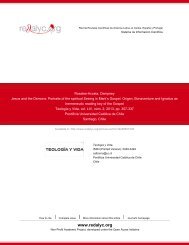A Key Concept in Modern Translation Theory - Redalyc
A Key Concept in Modern Translation Theory - Redalyc
A Key Concept in Modern Translation Theory - Redalyc
Create successful ePaper yourself
Turn your PDF publications into a flip-book with our unique Google optimized e-Paper software.
SERGIO BOLAÑOS CUELLAR<br />
73<br />
macro-textual equivalent relation, which also holds when a text is not actually translated<br />
but e.g. ‘transplanted’ <strong>in</strong>to a literary milieu” (p.197). 7<br />
We would like to close this part by quot<strong>in</strong>g J. House (1997), who summarizes<br />
her position <strong>in</strong> relation to the notion of equivalence and the way it has been criticized:<br />
“The attack aga<strong>in</strong>st the concept of ‘equivalence’ <strong>in</strong> the field of translation studies<br />
has a slightly dated touch: def<strong>in</strong>itions of equivalence based on formal, syntactic and lexical<br />
similarities alone have actually been criticized for a long time, and it has long been recognized<br />
that such narrow views of equivalence fail to recognize that two l<strong>in</strong>guistic units <strong>in</strong> two<br />
different languages may be ambiguous <strong>in</strong> multiple ways. Formal def<strong>in</strong>itions of equivalence<br />
have further been revealed as deficient <strong>in</strong> that they cannot expla<strong>in</strong> appropriate use <strong>in</strong><br />
communication. This is why functional, communicative or pragmatic equivalence have been<br />
accredited concepts <strong>in</strong> contrastive l<strong>in</strong>guistics for a very long time, focus<strong>in</strong>g as they do on<br />
language use rather than structure. It is these types of equivalence which have become<br />
particularly relevant for translation, and this is noth<strong>in</strong>g new (cf. Catford 1965).” (p.26)<br />
5. NEW PERSPECTIVES<br />
Perhaps the author who has developed the most <strong>in</strong>terest<strong>in</strong>g and useful <strong>in</strong>sights<br />
<strong>in</strong>to the notion of equivalence is Werner Koller (1978; 1992; 2000). His po<strong>in</strong>t of<br />
departure co<strong>in</strong>cides with our understand<strong>in</strong>g of the textual nature of translation,<br />
which is placed <strong>in</strong> the doma<strong>in</strong> of la parole and not la langue:<br />
“What is translated are utterances and texts; the translator establishes<br />
equivalence between SL-utterances/texts and TL-utterances/texts (SL=Source Language,<br />
TL=Target Language), not between structures and sentences of two languages.”(1978:76) 8<br />
Recently the author (Koller 2000) has proposed to dist<strong>in</strong>guish two concepts<br />
of equivalence:<br />
7<br />
“Es ist mir daher unverständlich, dass neuerd<strong>in</strong>gs der Begriff der Übersetzungsäquivalenz<br />
so <strong>in</strong> Misskredit geraten ist (Snell-Hornby 1986; 1988). Zwar ist richtig, dass die ÜW der 70<br />
Jahre den Äquivalenzbegriff teilweise zu rigide und zu statisch gesehen hat, aber wieso gerade die<br />
Vertreter des funktional-soziokulturellen übersetzungsprozessualen Ansätze den<br />
Äquivalenzbegriff ausheben wollen, ist mir e<strong>in</strong> Rätsel. Dies vor allem, weil die moderne ÜW, wie<br />
bereits mehrfach angedeutet, textbezogen argumentiert und man AT und ZT doch eigentlich gar<br />
nicht anders aufe<strong>in</strong>ander beziehen kann als <strong>in</strong> Form e<strong>in</strong>er, wie immer gearteten mikro- und<br />
makrokontextuellen Äquivalenzbeziehung, die auch dann besteht, wenn e<strong>in</strong> Text nicht eigentlich<br />
übersetzt, sondern –z.B. <strong>in</strong> literarischen Milieu- ‚transplantiert’ wird.”<br />
8<br />
“Übersetzt werden immer Äusserungen und Texte, der Übersetzer stellt Äquivalenz her<br />
zwischen AS- Äusserungen/Texten und ZP-Äusserungen/Texten (AS=Ausgangssprache,<br />
ZS=Zielsprache), nicht zwischen Strukturen und Sätzen zweier Sprachen.”
















